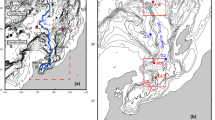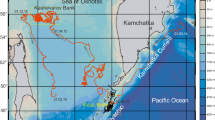Abstract
Although the Tsushima Current exhibits a complicated meander in the interior region of the Japan Sea, its path is more regular in the southwest region near the Tsushima Strait, and three branches have often been recognized there by many investigators. However, the detailed structures and temporal variabilities of these branches have not been clarified, and so they are studied here by analysing temperature, salinity and sea level data.
It is shown that the existence of the first branch (the nearshore branch along the Japanese coast) can be detected from salinity distributions at least during the period from March to August. The third branch (the Eastern Korean Current) exists in all seasons. On the other hand, the second branch (the offshore branch) is seasonally variable and can be identified only in summer from June to August.
Along the Japanese coast of southwest Japan Sea, the main pycnocline intersects the gentle slope on the shelf at a depth between 150 and 200 m. The first branch is found on the coastal side of the line where the main pycnocline intersects the bottom slope. On the other hand, the second branch is formed just on the seaward side of this line.
Sea level differences in the Tsushima Strait, i.e., between Hakata and Izuhara and between Izuhara and Pusan, show that the seasonal variation of the surface velocity (or volume transport) is small in the eastern channel and large in the western channel. The period during which the surface velocity and volume transport in the western channel increase corresponds well to the period during which the second branch exists.
These results suggest that the effects of bottom topography and oceanic stratification in the Japan Sea as well as the time variation of inflow through the western channel of the Tsushima Strait play important roles in the formation of the second branch.
Similar content being viewed by others
References
Central Meteorological Office of the Republic of Korea (1966–1976): Monthly weather report. Daily meteorological data for the standard meteorological stations (1966–1976).
Fisheries Research and Development Agency of the Republic of Korea (1974): Annual report of oceanographic observations,22. Sectional oceanographic data (1973).
Fisheries Agency, Japan (1972–1980): The results of Fisheries Oceanographical Observation. Hydrographical and BT observations (1969–1976).
Hydrographic Office of the Republic of Korea (1967–1977): Technical reports. Results of tidal observation (1966–1976).
Japan Maritime Safety Agency (1968–1978): Data report of hydrographic observations—Series of Tide (1966–1976), Nos. 4–13.
Japan Meteorological Agency (1966–1977): Monthly report of the Japan Meteorological Agency. Meteorological observations for Jan., 1966 to Dec, 1976.
Japan Meteorological Agency (1973–1978): The results of marine meteorological and oceanographical observations (Jan. to June, 1972–July to Dec, 1976), Nos. 51–60.
Kajiura, K., M. Tsuchiya andK. Hidaka (1958): The analysis of oceanographical condition in the Japan Sea. Rep. Develop. Fisher. Resour. in the Tsushima Warm Current,1, 158–170. (in Japanese).
Kawabe, M. (MS): Branching of the Tsushima Current in the Japan Sea, Part II. Numerical experiment. (submitted to J. Oceanogr. Soc. Japan).
Kawai, H. (1974): Transition of current images in the Japan Sea.In, The Tsushima Warm Current—Ocean structures and fishery, ed. by Fishery Soc. Japan, Kôseisha-kôseikaku, pp. 7–26 (in Japanese).
Miida, T. (1976): Current characteristics measured with current meters at fixed stations. Bull. Japan Soc Fish. Oceanogr., (28), 33–58 (in Japanese).
Moriyasu, S. (1972a): The Tsushima Current.In, Kuroshio—Its physical aspects. ed. byH. Stommel andK. Yoshida, Univ. Tokyo Press, Tokyo, pp. 353–369.
Moriyasu, S. (1972b): Hydrography of the Japan Sea. Marine Sciences (Kaiyô Kagaku),4, 171–177 (in Japanese with English abstract).
Naganuma, K. (1973): On the discussions on the existence of the third branch of the Tsushima Current. News letter of Japan Sea Regional Fisher. Res. Lab., (266), 1–3 (in Japanese).
Naganuma, K. (1977): The oceanographic fluctuations in the Japan Sea. Marine Sciences (Kaiyô Kagaku),9, 137–141 (in Japanese with English abstract).
Ogawa, Y. (1974): The relation between the high saline water in the Japan Sea and Tsushima Current. Bull. Japan Soc. Fish. Oceanogr., (24), 1–12 (in Japanese).
Ohwada, M. and K.Tanioka (1971): Currents and distributions of water masses in the Japan Sea. Rep. Study on the Japan Sea: Special budget for research in fiscal year 1969, Science and Technology Agency (Shôwa 44 nendo tokuchô-hi, Nipponkai ni kansuru sôgôkenkyû hôkokusho), 51–72 (in Japanese).
Shimomura, T. andK. Miyata (1957): The oceanographical conditions of the Japan Sea and its water systems, laying stress on the summer of 1955. Bull. Japan Sea Regional Fisher. Res. Lab., (6), 23–97 (in Japanese with English abstract).
Suda, K. andK. Hidaka (1932): The results of the oceanographical observations on board R.M.S. ‘Syunpû Maru’ in the southern part of the Japan Sea in the summer of 1929, Part 1. J. Oceanogr. Imp. Mar. Observ.,3, 291–375 (in Japanese).
Suda, K., K. Hidaka, Y. Matsudaira, E. Kurashige, H. Kawasaki, andT. Kubo (1932): The results of the oceanographical observations on board R.M.S. ‘Syunpû Maru’ in the southern part of the Japan Sea in the summer of 1930. J. Oceanogr. Imp. Mar. Observ.,4, 1–174 (in Japanese).
Tanioka, K. (1968): On the East Korean Warm Current (Tōsen Warm Current). Oceanogr. Mag.,20, 31–38.
Tsuchida, T. (1979): Observations in the Japan Sea. Marine Sciences (Kaiyô Kagaku),11, 169–174 (in Japanese).
Uda, M. (1934): The results of simultaneous oceanographical investigations in the Japan Sea and its adjacent waters in May and June, 1932. J. Imp. Fisher. Exp. St.,5, 57–190 (in Japanese with English abstract).
Uda, M. (1936): Results of simultaneous oceanographic investigations in the Japan Sea and its adjacent waters during October and November, 1933. J. Imp. Fisher. Exp. St.,7, 91–151 (in Japanese with English abstract).
Yi, S. (1970): Variations of oceanic condition and mean sea level in the Korea Strait.In, The Kuroshio. ed. byJ. C. Marr, East-West Center Press, Honolulu, pp. 125–141.
Author information
Authors and Affiliations
Rights and permissions
About this article
Cite this article
Kawabe, M. Branching of the Tsushima current in the Japan Sea. Journal of the Oceanographical Society of Japan 38, 95–107 (1982). https://doi.org/10.1007/BF02110295
Received:
Revised:
Accepted:
Issue Date:
DOI: https://doi.org/10.1007/BF02110295




